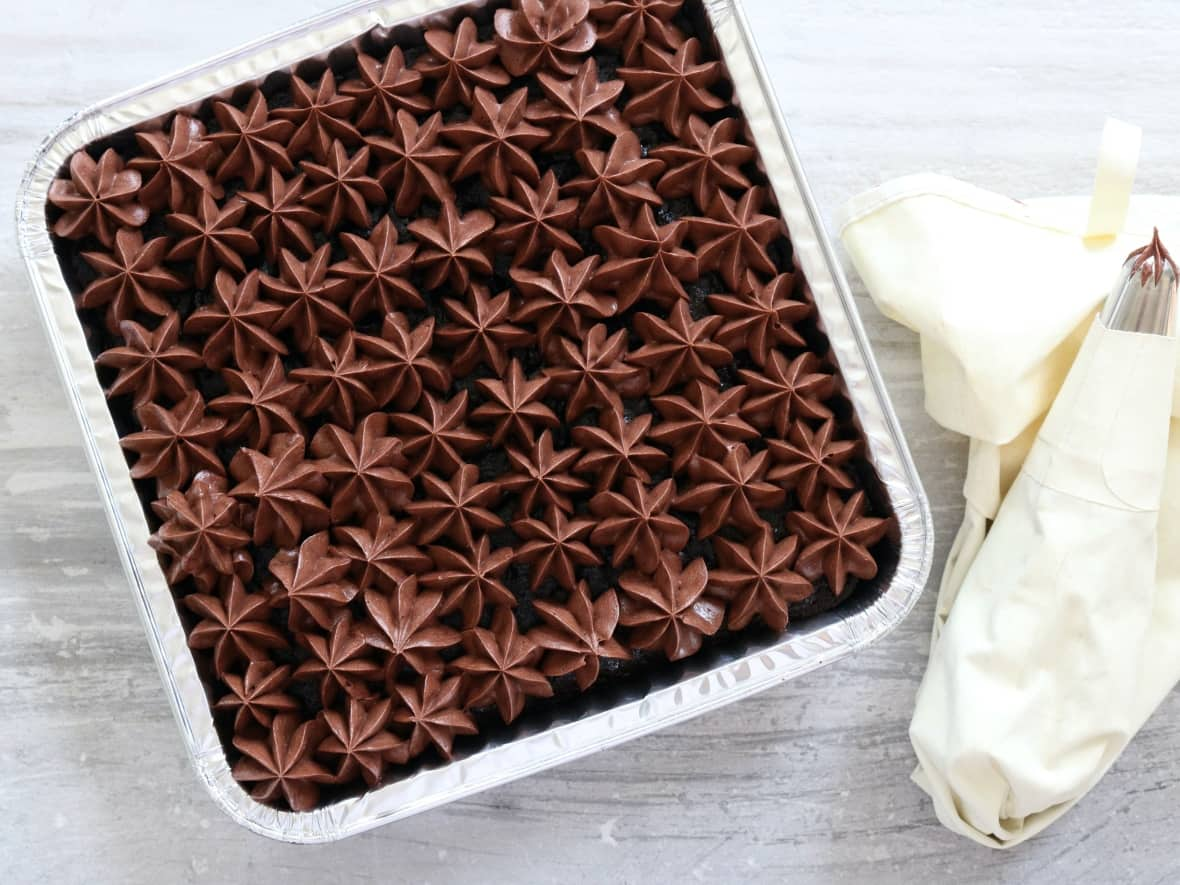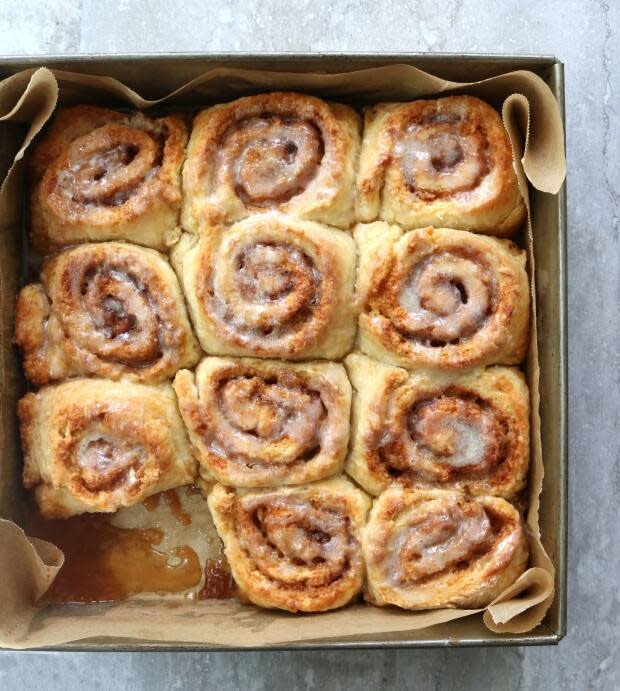Recipes with Julie Van Rosendaal: Plant-based baking

We're witnessing a global shift toward more plant-based eating, as consumers become more aware of the environmental consequences of our food system, concerned with animal welfare, or simply interested in the increasing number of plant-based options on grocery shelves.
While reducing or eliminating meat (and/or eggs and dairy products) from our main meals is relatively simple, baking is seen more as a science — and most recipes default to butter, milk and eggs.
Though baking does involve more precision, and recipes can be tricky to tinker with, it is possible to make cookies, cakes, pastries and other baked goods entirely plant-based.
And there's no need to frame these formulations as "alternatives" that are not ideal, or not as good as those made with more common ingredients.
We talked about how to bake without butter, milk and/or eggs on The Eyeopener.
Here's a few notes on each ingredient:
Milk:
This is the easy part — there are so many non-dairy milks on the market: oat, coconut, cashew… I like yellow pea-based milks like Sproud which have slightly higher protein content, and the new NextMilk, made by Silk, which is based on oat and coconut and is the closest in taste and texture to dairy milk I've tried.
Fats:
I default to canola or other neutral vegetable oils in cakes, muffins and quick breads (like banana bread). Liquid fats work well when you're using the quick bread method — combining the wet and dry ingredients separately, then stirring them together. When the flavour of butter is important (as in chocolate chip cookies), or when you need a more solid fat (if you're rubbing it into pastry or biscuit dough) or are beating it with sugar to incorporate air into the mixture, plant-based butters and margarines work well, though the tub-style varieties have more moisture and can result in a more cakey texture. Coconut oil, which is very solid at room temperature, also works well — on its own or combined with another fat — and will give your cookies a crisp edge. Shortening is plant-based and easy to use in pastry recipes, and is often the fat in frozen puff pastry, which is so simple to thaw and use.
Eggs:
Though eggs act as a binder and will help your baked goods rise, there are plenty of options if you can't or choose not to use eggs in your baking. A flax egg is a common substitute — stir 1 Tbsp ground flax with 2 1/2-3 Tbsp water to produce a viscous mixture that can help stabilize and bind batters much like an egg. Vegan mayonnaise, which is thickened with corn and potato starch, works well in cakes and batters, as does fruit puree (I like mashing thawed frozen bananas, which contain plenty of pectin and don't add as strong a banana flavour as overripe bananas from your fruit bowl) and aqua faba — the liquid drained from a can of chickpeas or kidney beans. (If you're not planning to use the beans, freeze them for later!) Soda water is a common addition in cakes and quick breads, and JustEgg is a fantastic new-ish product — made in Canada, from mung beans, it's a yolk-yellow liquid that can be used in place of eggs in everything from baked goods, pancakes and the like, to quiches and scrambled eggs. I've tried all of the above, with astounding success.
A few more tips that may help in the absence of egg: try using bread flour, which has a higher protein content (more gluten), which gives your baked goods more structure and elasticity, similar to the presence of egg in your dough or batter. You can also let your muffin, cake or quick bread batter sit in the pan for 20-30 minutes before putting it in the oven, which gives the baking soda or powder time to generate more carbon dioxide bubbles before it begins to bake. (You could increase the quantity of baking powder or soda as well, but do it in small amounts, as too much can give your baking a metallic taste!)
Plant-based Deep n' Delicious Chocolate Cake

I like using a mashed overripe banana from the freezer in this cake, which minimizes the banana flavour. (The quantity is a range, as bananas vary in size.) To make cupcakes, divide the batter between paper-lined muffin cups and bake for 20-25 minutes, until springy to the touch.
1 cup oat, yellow pea, coconut or other non-dairy milk
1 Tbsp lemon juice
2 cups all-purpose flour
1 3/4 cups sugar
3/4 cup cocoa
2 tsp baking powder
1 tsp baking soda
1/2 tsp fine salt
1/2 cup canola or vegetable oil (or 1/4 cup melted plant-based margarine + 1/4 cup oil)
1/3 cup vegan mayonnaise
1/3-1/2 cup mashed overripe banana (or pumpkin purée)
2 tsp vanilla
1 cup hot coffee (decaf is fine! I keep instant on hand for baking)
Frosting:
1/2 cup plant-based butter
3 cups icing sugar
1/3 cup cocoa
1/4-1/3 cup oat, pea or other non-dairy milk (or water)
1 tsp vanilla
pinch salt
Preheat the oven to 350˚F.
In a small bowl or measuring cup, stir the lemon juice into the milk and let it sit while you mix the rest of the batter.
In a large bowl, whisk together the flour, sugar, cocoa, baking powder, baking soda and salt. In another bowl, whisk together the oil, mayonnaise, mashed banana or applesauce and vanilla. Add to the dry ingredients along with the milk, and stir just until combined. Add the hot coffee, and whisk until the batter is smooth.
Spray two 8 or 9-inch round or square cake pans or a 9x13-inch pan with nonstick spray and divide the batter between them (or pour into a 9x13-inch pan). Bake for 35-40 minutes or until slightly domed and the middle of the cakes are springy to the touch. Cool completely before frosting.
To make the frosting, beat the butter, icing sugar, cocoa, about half the milk or water, vanilla and salt until smooth and lighter in texture, adding more liquid as needed to make it fluffy and spreadable. (If you use unsalted margarine, add a pinch of salt.) Spoon into a piping bag with a star tip and pipe rows of frosting blossoms on top of the cake, or spread it over the top with a knife.
Makes two 9x9-inch square or round cakes or one 9x13-inch sheet cake.
Oatmeal Chocolate Chunk Cookies
A chewy oatmeal-chocolate chunk cookie is a beautiful thing. These use boiling water and baking soda in place of the egg, and are based on a classic from the yellow Best of Bridge book, Enjoy! I like to push a chocolate chunk in the top of each one too, to make sure each cookie gets one, and to make them look extra chocolatey.
1 cup plant butter or coconut oil (or a combination)
3/4 cup packed brown sugar
1/4 cup sugar
2 tsp vanilla
1 1/2 cups all-purpose flour
1/2 tsp fine salt
1 tsp baking soda
1/3 cup boiling water
1 1/2 cups old-fashioned or quick oats
1-2 cups (or so) chopped dark chocolate or vegan chocolate chips
1/2 cup chopped walnuts or pecans (optional)
Preheat the oven to 350˚F.
In a large bowl, beat the butter, sugars and vanilla for 1-2 minutes, until pale and light. Stir in the flour and salt (or beat it in on low speed). Stir the baking soda into the boiling water and stir or beat it in too, along with the oats, chocolate chips and walnuts.
Drop the dough in large spoonfuls (or us a scoop, or roll into balls) and if you like, press an extra chunk of chocolate (or a few chocolate chips) into the top with your hand.
Bake for 12-15 minutes, until deep golden around the edges but still soft in the middle. Transfer to a wire rack to cool.
Makes about 1 1/2 dozen cookies.
Cinnamon Sticky Biscuits
I've been making these sticky biscuits for decades — they're much faster than traditional yeast-raised cinnamon buns, but no less delicious! If you like, drizzle the not-gooey side with a glaze made with 1/3 cup icing sugar, 1 Tbsp each plant butter and (non-dairy) milk while they're still warm. Sometimes I do this, and other times I invert them onto a plate or board to serve sticky-side-up.
Stickiness:
1/4 cup plant butter or margarine
1/4 cup packed brown sugar
1/4 cup Roger's Golden or maple syrup
2 Tbsp water (optional)
Biscuits:
2 cups all-purpose flour
1 Tbsp baking powder
1/2 tsp salt
3/4 cup oat, yellow pea or other non-dairy milk
1/4 cup canola or other mild vegetable oil
Filling:
1/2 cup packed brown sugar
1/4 cup (ish) Roger's Golden or maple syrup (you can free-pour this!)
cinnamon
Preheat the oven to 350°F.
Put the butter, brown sugar, syrup and water into a parchment-lined or buttered 8x8 or 9x9-inch pan. Put the pan in the oven as it preheats for about 5 minutes, or just long enough to melt the butter. Pull out the pan and stir everything together with a fork.
Meanwhile, in a medium bowl, combine the flour, baking powder and salt. Add the milk and oil and stir just until you have a soft dough.
On a lightly floured surface, pat or roll the dough into about a 9 x 12-inch rectangle (aim for a bit bigger than a standard sheet of paper — it doesn't have to be perfect). Sprinkle with brown sugar, drizzle with syrup (you can eyeball this, no need to precisely measure) and sprinkle with cinnamon. Starting from a long side, roll tightly jelly-roll style into a log.
Cut into 9 or 12 biscuits using dental floss or a serrated knife, and place cut side down in the pan. Bake for 20 minutes, until golden. Drizzle them with a simple glaze if you like, or invert onto a plate while still warm.
Makes 9-12 biscuits.


